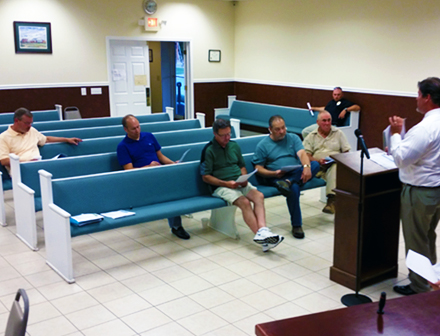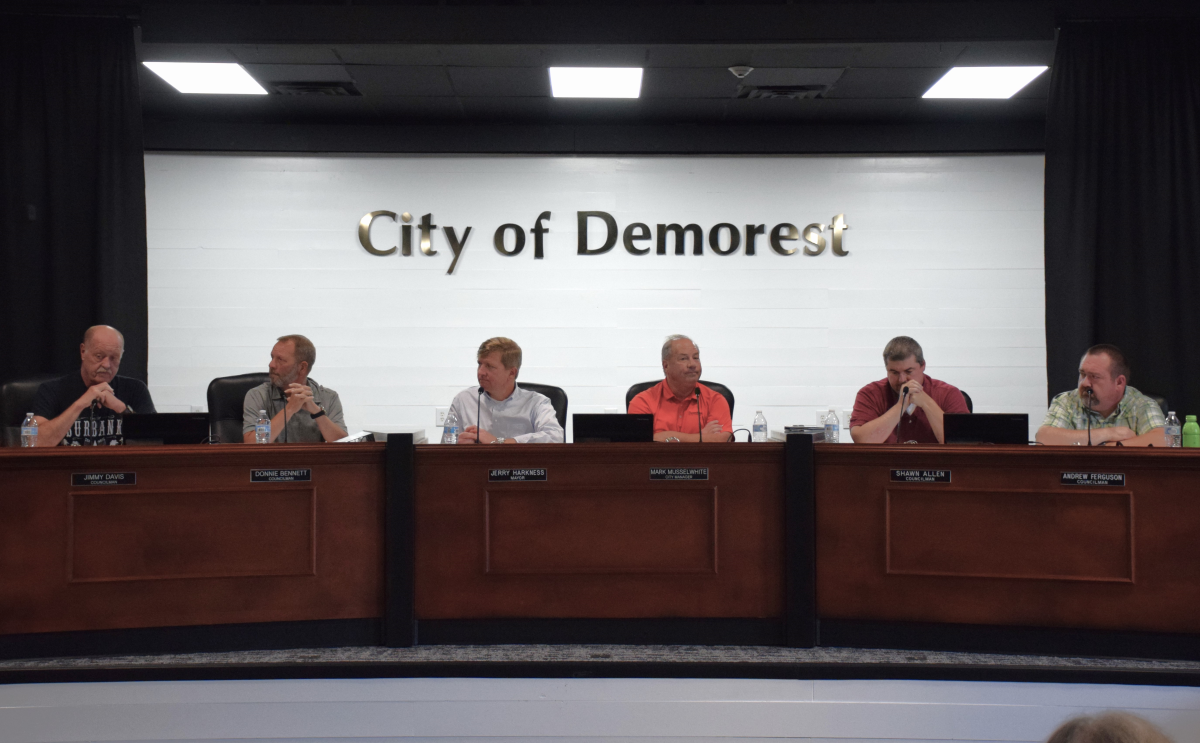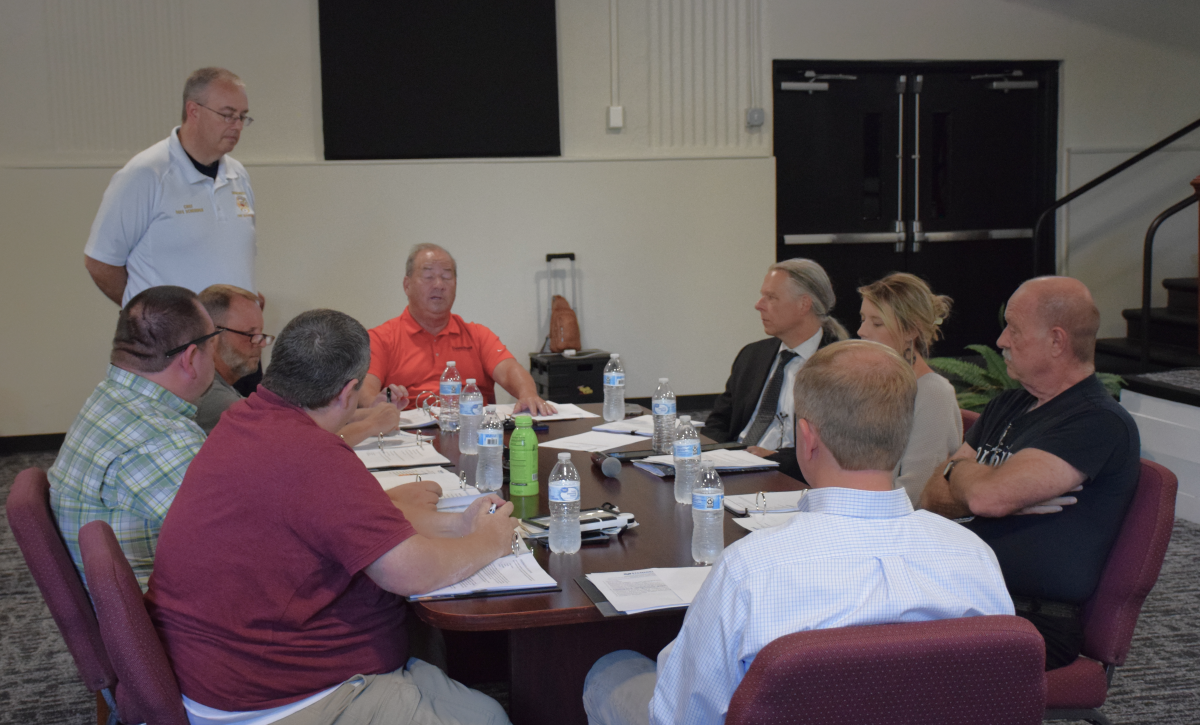
City leaders have known for years that Baldwin’s wastewater treatment plant doesn’t work very well. Now they must decide if they want to spend $8 million to build a new one or spend $4.75 million to partially patch up the one they have.
Baldwin Council Members met this week with their consultants from Engineering Management Incorporated (EMI) and Jeff McLeod from the United States Department of Agriculture (USDA).
The folks from EMI have worked up two different plans to repair the sewer plant and hope to get the USDA to help pay for it.
What’s Wrong with Baldwin’s Wastewater Plant?
Baldwin’s sewer plant was originally built in the 1970s. They did an upgrade in 2003 but the piece that is supposed to filter equipment-damaging debris from entering the plant, the “headworks,” never worked properly. Engineers say, over the past decade, every pipe and piece of equipment they have was damaged by the debris-laden water coming into the plant.
There’s also a problem with the size of the lines. The prison in Alto is the city’s largest customer and the Department of Corrections wanted an upgrade at the plant to process 800,000 gallons a day. They did that but the pipes leading to the plant can’t actually handle that much. According to a 2011 report from former Supervisor Chad Conard, “The plant is supposed to handle 800,000 gallons a day but when it gets to 600,000 gallons everything begins to overflow and operators go into emergency measures.” The same report states that the facility’s wiring is also a mess.
All these problems mean high annual operations and maintenance costs. Baldwin paid $641,907 just to keep the plant up and running during this year.
What do the Consultants Suggest?
The $8 million plan replaces almost everything at the current plant. It promises to correct all the mistakes of the past and fully update the plant beyond current state environmental requirements. EMI believes it will make the whole operation more efficient which would lower the cost of running the plant by a considerable amount.
The $4.7 million plan replaces the defective headworks and adds two clarifiers to the existing system to address a handful of immediate issues.
How Can Baldwin Afford Either Plan?
Either choice will require Baldwin to take on 40 more years of debt. Paying it back would fall to the city’s sewer customers meaning monthly sewer bills would increase. How much more folks would pay depends on which plan leaders choose and how they finance it.
If they have to borrow the full $8 million, the average household sewer bill increases to roughly $49 per month.
The $4.75 million plan with straight financing would see bills go up to $46 per month. The costs for commercial and industrial customers would rise too.
The folks at EMI who came up with the plan project that your bills would rise much less if the city can get the USDA to provide a grant for 75% of the cost. “You get a 7% rate increase for a 4 million dollar project or a 2% rate increase for the 8 million dollar project (with USDA help),” according to EMI Project Manager Chip McGaughey. The reason the more expensive plan would cost ratepayers less is because fixing the whole plant makes it cheaper to operate.
Spend Money to Save Money?
According to EMI, fully rebuilding the plant would result in an estimated $162,806 annual savings in operations and maintenance costs over what the city paid this year. If the USDA grant doesn’t come through and the city had to finance the full note, the annual savings would initially cover more than half of the city’s annual loan payment on the $8 million. If the feds pay 75% of the total, the annual loan payment drops to $74,266.47.
Annual savings on operations and maintenance are much less with the cheaper plan because many of the existing problems would remain. The city would realize about $55,306 in O&M savings per year and still face an annual loan payment of $176,382.86.
Georgia DOC Wins Either Way?
The Georgia Department of Corrections comes out a winner no matter which plan Baldwin chooses. Their costs will drop under either proposal because, due to a lawsuit settlement, much of their sewer rate is based the cost of operating and maintaining the system.
Will the Feds Help Pay?
“I can’t obligate the government as far as what we could do,” says the USDA’s Jeff McLeod. “The 75% grant comes if income here is low enough, which it is, but also you have to have documentable health and safety hazards.”
Baldwin has those “hazards.” The city includes a couple thousand dollars in each year’s budget to pay Environmental Protection Division fines from sewage spills and other problems. This year the fines totaled more than $3,391.
McLeod says the USDA is eager to help communities like Baldwin. In this case, the government’s interest is to reduce health and safety hazards and to keep folks’ sewer rates from rising too high because much of Baldwin’s population lives close to the poverty line.
Timing is also an issue. USDA has a large pool of federal tax dollars set aside specifically for rural development in Georgia. According to McLeod, “Georgia is number 2 in the nation for allocations but we’re not using our funds like they (USDA) would like for us to.” He says if they don’t get those funds obligated to projects here within the next few months, the Washington D. C. office will take Georgia’s money and use it in other states. Leaders say that makes the agency “motivated” to back Baldwin’s sewer plant.
What’s Next?
The USDA can’t approve any funding until Baldwin leaders pick which plan they want to pursue. City Council will discuss the issue further at their planned work session July 9.






